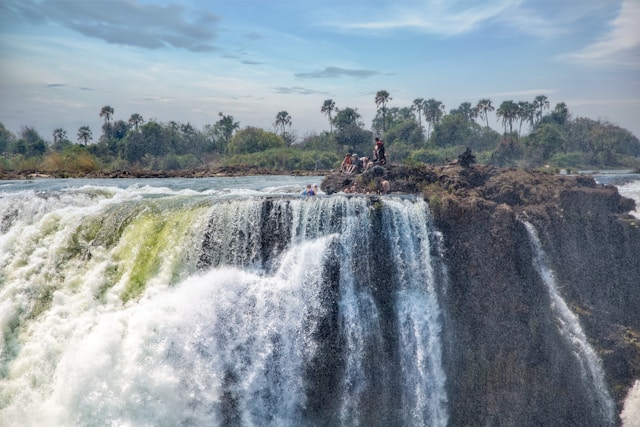The world’s largest waterfall, when measured by overall size and volume, is Victoria Falls. Here are detailed insights into this magnificent natural wonder:
Victoria Falls is the World’s Largest Waterfall
Physical Characteristics:
- Dimensions: Victoria Falls is approximately 1,708 meters (5,604 feet) wide, making it the largest curtain of falling water in the world.
- Height: The falls have a height ranging from 80 meters (262 feet) to 108 meters (354 feet) along the drop.
- Volume: During the rainy season, typically from February to May, the Zambezi River, which feeds the falls, flows at a rate of up to 12,800 cubic meters (450,000 cubic feet) per second, making it one of the most powerful waterfalls by volume.
Location:
- Geography: Victoria Falls is located on the border between Zambia and Zimbabwe in Southern Africa.
- River Source: It is fed by the Zambezi River, which is the fourth longest river in Africa and serves as a vital water source for the region.
Discovery and Name:
- Local Name: The indigenous name for the falls is “Mosi-oa-Tunya,” meaning “The Smoke That Thunders,” describing the mist and loud noise created by the falling water.
- European Discovery: The famous Scottish explorer David Livingstone is credited with bringing the falls to international attention in 1855, naming them after Queen Victoria.

Victoria Falls bordering Zimbabwe and Zambia is the World’s Largest Waterfall
Significance of The Largest Waterfall in the World:
- UNESCO World Heritage Site: Victoria Falls is recognized as a World Heritage Site due to its unique geological and geomorphological features.
- Biodiversity: The area around the falls is rich in biodiversity, hosting various plant species and wildlife, including elephants, hippos, and several bird species.
Tourism and Activities:
- Tourist Attraction: One of Southern Africa’s major tourist destinations, visited by hundreds of thousands of people each year.
- Activities: Popular activities include guided tours of the falls, helicopter flights for aerial views, white-water rafting on the Zambezi, and swimming in the naturally formed “Devil’s Pool” at the edge of the falls during the drier months.
Environmental Impact:
- Seasonal Variation: The flow of water over the falls varies dramatically between the dry and wet seasons, affecting the volume and appearance of the waterfall.
- Conservation Efforts: Efforts are ongoing to protect and manage the natural environment of the falls, balancing tourism with conservation.
Victoria Falls is renowned for its stunning beauty and grandeur, offering breathtaking views and thrilling activities for those who visit. It stands as a testament to nature’s power and majesty, capturing the imagination and admiration of explorers and adventurers from around the world.
Isn’t Niagara Falls the World’s Largest Waterfall?
When it comes to measuring and comparing waterfalls, the concept of “largest” can be interpreted in different ways, such as width, height, or volume of water flow. Here’s how Victoria Falls distinguishes itself compared to Niagara Falls:
Victoria Falls:
- Width: Victoria Falls boasts an impressive width of about 1,708 meters (5,604 feet), making it one of the widest waterfalls in the world.
- Height: The falls have a height ranging from 80 meters (262 feet) to 108 meters (354 feet).
- Volume: During peak flow in the wet season, Victoria Falls has an average flow rate of about 1,088 cubic meters per second (38,430 cubic feet per second), though this can vary significantly based on seasonal rains.
- Curtain of Water: Victoria Falls is often described as the largest curtain of falling water in the world because of its combined width and height, creating a massive sheet of water.
Niagara Falls:
- Width: The combined width of the American Falls and Horseshoe Falls (which make up Niagara Falls) is about 1,200 meters (3,950 feet), with the Horseshoe Falls being the widest single section.
- Height: Niagara Falls has a height of about 51 meters (167 feet).
- Volume: Niagara Falls generally has a flow rate of about 2,400 cubic meters per second (84,755 cubic feet per second), which is greater than that of Victoria Falls on average.
- Accessibility: Niagara Falls is extremely accessible and has a large infrastructure to support tourism, making it one of the most famous and visited waterfalls globally.

How does Niagara Falls compare to Victoria Falls?
Why Victoria Falls is Considered “Larger” than Niagara Falls:
- Combining Height and Width: Victoria Falls is considered the largest sheet of falling water in the world when considering both its great width and height together.
- Visual Impact: The vast curtain of water falling into the Batoka Gorge creates a dramatic visual spectacle—often referred to as “The Smoke That Thunders” due to the mist and roar produced by the falls.
In summary, while Niagara Falls has a greater volume of water flow, Victoria Falls’ combined height and width earn it the title of the largest waterfall in terms of the overall mass of falling water, making each of these falls unique and outstanding in their own right.

